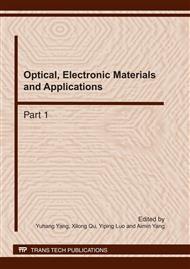[1]
M. Abdalla, P.A. Fouque, and D. Pointcheval. Password-based authenticated key exchange in the three-party setting, IEE Proceedings in Information Security, Vol. 153, No. 1 (2006), pp.27-39.
DOI: 10.1049/ip-ifs:20055073
Google Scholar
[2]
M. Bellare, D. Pointcheval, and P. Rogaway. Authenticated key exchange secure against dictionary attacks, Eurocrypt'00, (2000), pp.139-155.
DOI: 10.1007/3-540-45539-6_11
Google Scholar
[3]
W. Diffie, M. Hellman, New directions in cryptography, IEEE Transactions on Information Theory, IT-22, No. 6 (1976), p.644–654.
DOI: 10.1109/tit.1976.1055638
Google Scholar
[4]
B.T. Hsieh, H.M. Sun, T. Hwang, Cryptanalysis of enhancement for simple authentication key agreement algorithm, Electronics Letters, Vol. 38, No. 1 (2002), pp.20-21.
DOI: 10.1049/el:20020012
Google Scholar
[5]
C.L. Hsu, T.S. Wu, T.C. Wu, C. Mitchell, Improvement of modified authenticated key agreement protocol, Applied Mathematics and Computation, Vol. 142 (2003), p.305–308.
DOI: 10.1016/s0096-3003(02)00304-1
Google Scholar
[6]
W.C. Ku, S.D. Wang, Cryptanalysis of modified authenticated key agreement protocol, Electronics Letters, Vol. 36, No. 21 (2000), p.1770–1771.
DOI: 10.1049/el:20001269
Google Scholar
[7]
N.Y. Lee, M.F. Lee, Further improvement on the modified authenticated key agreement scheme, Applied Mathematics and Computation, Vol. 157, No. 3 (2005), pp.729-734.
DOI: 10.1016/j.amc.2003.08.057
Google Scholar
[8]
S.W. Lee, H.S. Kim. K.Y. Yoo, Improvement of HWWM-authenticated key agreement protocol, Applied Mathematics and Computation, Vol. 162 (2005), pp.1315-1320.
DOI: 10.1016/j.amc.2004.03.010
Google Scholar
[9]
S.W. Lee, H.S. Kim. K.Y. Yoo, Improvement of Lee and Lee's authenticated key agreement scheme, Applied Mathematics and Computation, Vol. 162 (2005), pp.1049-1053.
DOI: 10.1016/j.amc.2004.01.011
Google Scholar
[10]
I.C. Lin, C.C. Chang, M.S. Hwang, Security enhancement for the simple authentication key agreement algorithm, The 24th Annual International Computer Software and Applications Conference, (2000), pp.113-115.
DOI: 10.1109/cmpsac.2000.884699
Google Scholar
[11]
D.H. Seo, P. Sweeney, Simple authenticated key agreement algorithm, Electronics Letters, Vol. 35, No. 13 (1999), p.1073–1074.
DOI: 10.1049/el:19990724
Google Scholar
[12]
H. Sun, On the security of simple authenticated key agreement algorithm, Proceedings of the Management Theory Workshop'2000, (2000).
Google Scholar
[13]
Y.M. Tseng, Weakness in simple authenticated key agreement protocol, Electronics Letters, Vol. 36, No. 1 (2000), p.48–49.
DOI: 10.1049/el:20000112
Google Scholar
[14]
Y.M. Tseng, Efficient authenticated key agreement protocols resistant to a denial-of-service attack, International Journal of Network Management, Vol. 15 ( 2005), pp.193-202.
DOI: 10.1002/nem.561
Google Scholar
[15]
E.J. Yoon, K.Y. Yoo, Robust ID-based remote mutual authentication with key agreement protocol for mobile devices on ECC, 2009 International Conference on Computational Science and Engineering, (2009), pp.633-640.
DOI: 10.1109/cse.2009.363
Google Scholar


